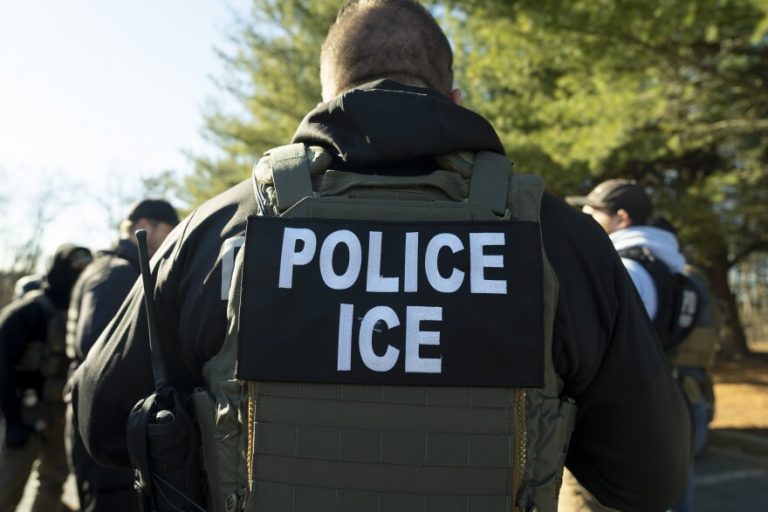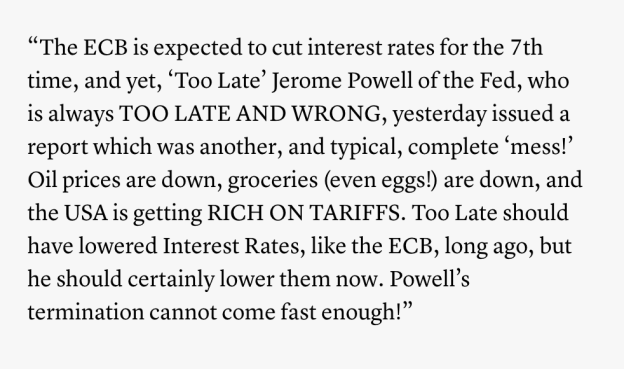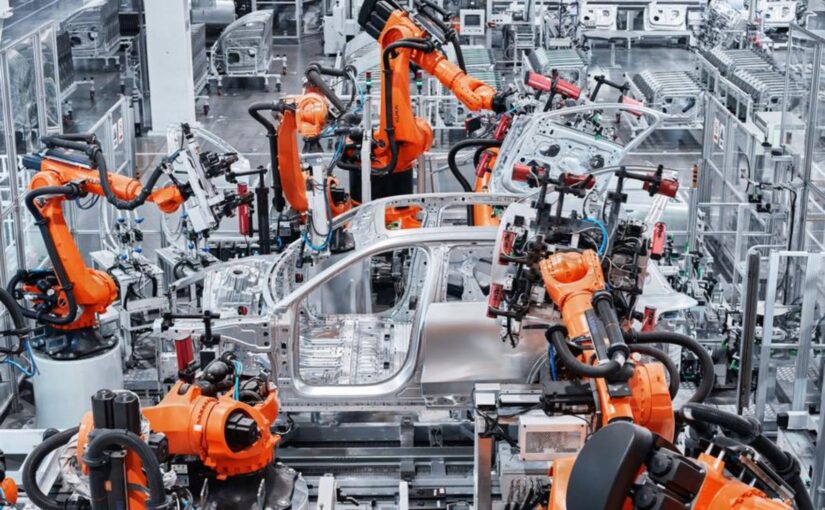
by John Helmer, Moscow @bears_with
It’s Easter for Christians, and President Donald Trump’s message is a religious one.
He aims to be one of the angels of deliverance whom the gospels report to have showed themselves at the tomb of Jesus Christ after the crucifixion. Rolling the stone from the entrance to the tomb, and in place of his corpse, the appearance of the angels confirmed the resurrection.
“Through the pain and sacrifice of Jesus on the Cross,” Trump has tweeted, “we saw God’s boundless Love and Devotion to all Humanity and, in that moment of His Resurrection, History was forever changed with the Promise of Everlasting Life.” He went on: “America is a Nation of Believers. We need God, we want God and, with His help, we will make our Nation Stronger, Safer, Greater, more Prosperous, and more United than ever before.”
Trump had announced his own personal divine deliverance last July, when he was grazed in an assassination attempt. “It was God alone who prevented the unthinkable from happening. We will FEAR NOT, but instead remain resilient in our Faith and Defiant in the face of Wickedness.” He repeated his divine deliverance in his inaugural address of January 20: “I was saved by God to make America great again.” In Congress on March 4, Trump repeated the divine mission. “I believe I was saved by God to make American great again. I believe that.”
On Palm Sunday he added that he was “in prayer with Christians celebrating the crucifixion and resurrection of our Lord and Savior, Jesus Christ—the living Son of God who conquered death, freed us from sin, and unlocked the gates of Heaven for all of humanity.” The White House log identified Trump’s only event of the day was to play golf from mid-morning until mid-afternoon.
In this new podcast, Nima Alkhorshid leads the discussion of what Trump is expecting to be believed in the negotiations he is holding with Russia and with Iran; and of what he and his officials are actually doing.
Three main documents were referred to in the discussion.
The first is the published version of Trump’s medical examination last week. https://static01.nyt.com/newsgraphics/d ... 7-full.pdf

Source: https://static01.nyt.com
A specialist geriatrician who was consulted for a review of this report has commented that the 99% oxygenation level reported appears to be abnormally high; if accurate, the number may reflect prior stimulation in a hyperbaric chamber. The source also expresses scepticism that at Trump’s height (191cm), body weight (102kg) and body mass index (28, overweight range), the reported blood pressure score of 128 over 74 is too low unless he is taking undisclosed hypertension medication. The source adds that the neurological test reported of the Montreal Cognitive Assessment is inappropriate. This is used to measure dementia presentations in patients with Parkinson’s Disease or suspected Alzheimer’s Disease. It is not a measure of cognitive function. For that, tests of oral and written language use, conceptual complexity, and memory are appropriate. The evidence of these shows abnormally low cognitive function for Trump: click here and here.
For the Russian reaction to Trump’s statements and the negotiations he has directed Steven Witkoff and other officials to hold in Riyadh, Istanbul, Washington, and most recently in Moscow, here are excerpts of Foreign Minister Sergei Lavrov’s interview with Kommersant, published on April 14.

Source: https://mid.ru/en/foreign_policy/news/2009093/?lang=en
“Question: There were several rounds of talks with the United States since the new administration came to power there. What would be your assessment of how these contacts panned out? Have they resulted in outlining the key parameters for the future comprehensive agreement on Ukraine? On which of its elements have Washington and Moscow already reached common ground?
Sergey Lavrov: Let me answer your last question right away. The answer is no. Agreeing on the key aspects of the settlement is easy. We are discussing them…
Question: From what you have said, it sounds like Moscow still believes the US can be a negotiator in the Ukraine conflict. There have already been two US-mediated agreements: one on safe navigation in the Black Sea and another on a moratorium on strikes against energy infrastructure. But neither seems to be fully functioning. What’s your take on that?
Sergey Lavrov: There are no such agreements.”
In the interview, Lavrov downplayed the role of Kirill Dmitriev, whom he referred to, not by his new presidential emissary title, but by his older job function. “The economy and trade constitute the third track. Americans mentioned it at the first stage when President of the United States Donald Trump and President Vladimir Putin had their first telephone conversation, as well as when Presidential Envoy Steve Witkoff came here, and when Kirill Dmitriev, who heads the Russian Direct Investment Fund, was in the United States. They are businesspeople. Generating tangible returns is something that matters for them, and Donald Trump has made no secret out of it. This is his mindset and his policy. This is what the people of America voted for. It is obvious that they seek to generate benefits.”
https://johnhelmer.net/the-angels-of-de ... more-91397
*******
Trump Targets Migrants amid Human Trafficking Allegations
Posted by Internationalist 360° on April 16, 2025
Francisco Dominguez and Roger D. Harris

Trump is also trying to terminate the Humanitarian Parole program for Cubans, Haitians, Nicaraguans, and Venezuelans (CHNV)
Donald Trump has launched an aggressive campaign that targets Latino migrants – particularly Venezuelans – as scapegoats in a broader geopolitical agenda. Bolstered through a controversial alliance with the Salvadoran president, Trump has overseen mass deportations, detentions in Guantánamo Bay and El Salvador’s notorious CECOT prison, and invoked 18th-century war powers to justify these actions.
Trump’s brutal attacks on the working class have been supplemented by the systematic demonization of immigrants – many of whom are themselves working class. During his electoral campaign, Trump not only promised large-scale deportations but, pandering to a far-right base, vilified migrants to unprecedented degrees.
In his 2015 campaign, Trump vowed to deport millions of undocumented immigrants. And upon returning to the presidency in 2025, Trump again promised to round up millions in what he boasted would be the largest deportation operation in US history.
However, as the record shows, immigrant deportations are, unfortunately, a bipartisan project. Contrary to Trump’s grandiose rhetoric, once in office for his first term, he deported less than one million rather than the 11 million he claimed would be expelled. That was less than the 1.6 million evicted by his Democratic predecessor Barack Obama in a his first 4 years in office. While Democrat Joe Biden still holds the record for the most deportations in a year, Trump is determined to beat it.
To this end, Trump and his ultra-conservative Project 2025 confederates would like to end birthright citizenship, which would disproportionately affect nearly 65 million Latinos in the US. Arbitrary arrests, deportations, and the revocation of documentation – even for legal residents – are escalating daily, with Latino immigrants being the primary target in operations rife with racial profiling.
Trump is also trying to terminate the Humanitarian Parole program for Cubans, Haitians, Nicaraguans, and Venezuelans (CHNV), although the revocation has been halted pending legal proceedings. Ironically, Secretary of State Marco Rubio, once a vocal advocate for Cuban immigrants, now spearheads policies stripping them of legal protection.
Trump’s Fictional Gang Scare
Trump’s demonization of migrants affords him a patina of populism by falsely posing as a supporter of US workers erroneously threatened by aliens. Of course, Elon Musk’s buddy is no friend of the working class.
There is another more deeply political underpinning to Trump’s campaign related to Venezuela. Trump has falsely accused some Venezuelan migrants of being members of the Tren de Aragua gang on the flimsiest of reasons such as a tattoo in support of a football club. Thus immigrants, especially from Venezuela, are conflated with criminality. In fact, studies show US immigrants do not commit crime at a higher rate than the native-born.
In a highly redacted document, the US designatedTren de Aragua to be a “transnational criminal organization” (TCO) in December 2024. This came after the Venezuelan government largely dismantled the gang in September 2023 at Tocorón Penitentiary, demonstrating the government’s antagonistic relationship to the gang. But its existence was being politically weaponized by the US.
On his first day in office, Trump initiated the process of designating the gang as a foreign terrorist organization (FTO), legally making it a crime to provide it material support. In so doing, a circle of conflation was being constructed from migrant, to criminal, to gang member, and then the big leap to terrorist.
The final link in the circle of conflation was Trump’s invocation on March 15 of the Alien Enemies Act accusing the Venezuelan government of an “invasion” of the US by the Tren de Aragua.
A media campaign – spearheaded by Trump in concert with far-right Venezuelan opposition leader Maria Corina Machado and US senators like Ted Cruz– has propagated the myth of a Venezuelan government-backed Tren de Aragua cartel flooding the US with criminals. Venezuelan President Nicolás Maduro has described this as “the biggest lie ever told about our country.” To wit, El Pais verified the gang is “without the capacity to be a national security problem” the US. The New York Times demonstrated that the Tren de Aragua is “not invading America.” And Trump’s own US Intelligence Community assessment concluded that the gang was not acting on the Venezuelan government’s orders.
Alien Enemies Act
Trump’s invocation of the Alien and Enemies Act serves dual purposes. It is a legal pretext to justify mass expulsions. At the same time, it is a salvo in Washington’s renewed “maximum pressure” regime-change campaign against Caracas.
The application of the Alien Enemies Act for deporting individuals based on alleged gang affiliations is unprecedented and has raised legal and ethical concerns. While being adjudicated in the courts, the archaic 1789 war-time legislation is being used to target Venezuelans and Nicaraguans, even though the US is not at war with these countries…at least not officially. Nevertheless, some have been sent to detention facilities like the notorious internment camp in Guantánamo Bay.
The administration’s lack of transparency regarding deportation criteria has been staggering, as has its blatant disregard for due process. Many deportees were detained without evidence, arrest warrants, or probable cause – let alone justification for imprisonment.
The degrading treatment of detainees in Guantánamo has drawn wide condemnation as has the administration’s obsessive drive to deport Latinos – whether undocumented, temporary, or permanent.
Migrants Vanish into Trump’s Offshore Prison
Trump is also shipping Venezuelan migrants and lesser numbers of Salvadorians to El Salvador’s CECOT prison, a so-called “Terrorism Confinement Centre,” where conditions are subhuman. No visitation, recreation, or education are allowed at the extremely overcrowded facility. Lack of medical care and abuse are rampart, with reports of over 300 deaths in custody, some showing clear signs of violence.
The Trump administration struck a deal with Salvadoran President Nayib Bukele, paying $6 million to detain 238 Venezuelans branded “foreign terrorists.”
Meanwhile, Bukele boasted about the financial benefits of the arrangement. His Ocio Cero (zero leisure) prison labour program will, he said, contribute to the economic self-sustainability of the prison system, which critics say is tantamount to human trafficking.
Trump and Bukele both falsely claim to have no power to bring back a mistakenly deported Salvadoran legal immigrant. Kilmar Armando Abrego García is now held at CECOT, even though a US judge ordered his return and despite the US Supreme Court’s ruling to do so. Instead, Trump and Bukele declared their intention to expand the scheme. Trump floated deporting even US citizens to CECOT, with Bukele responding: “Yeah, we’ve got space.”
BPR (Bloque de Resistencia y Rebeldía Popular), a Salvadoran human rights organization denounced the Trump-Bukele pact as “arbitrary and dehumanizing,” violating international law and making El Salvador complicit in Trump’s criminalizing immigration policies. They demanded the Supreme Court nullify the detentions, arguing they violate constitutional protections against foreign judicial overreach.
Venezuela’s government has also taken action. Attorney General Tarek Williams Saab petitioned El Salvador’s Supreme Court for habeas corpus relief for detained Venezuelans. President Maduro condemned the deportations as kidnappings and sought intervention from the U.N. by contacting Secretary General Antonio Guterres and the U.N. high commissioner for human rights.
President Maduro has vowed to fight for the repatriation of every wrongfully detained Venezuelan. This struggle must be joined by the international solidarity movement, demanding the immediate release of all unjustly imprisoned migrants.
https://libya360.wordpress.com/2025/04/ ... legations/
******
Trump’s Tariffs Just Torched His Own Energy Agenda
Posted on April 17, 2025 by Yves Smith
Yves here. We, like many others, have described how Trump’s economic policies are rife with contradictions. The impact of tariffs on his prized LNG ambitions are a prime example.
By Tsvetana Paraskova, a writer for Oilprice.com with over a decade of experience writing for news outlets such as iNVEZZ and SeeNews. Originally published at OilPrice
President Trump’s tariff-driven price slump threatens America’s hard-won petroleum export surplus.
Ongoing tariff uncertainty and volatile oil prices make budgeting and drilling decisions difficult.
With a cash-flow breakeven around $62.50–$65/barrel, U.S. producers fear lower prices will stall new well drilling and long-term growth.
The Trump Administration insists that U.S. shale will survive lower oil prices and could work well and innovate further at current price levels of WTI crude prices of about $60 per barrel, and even lower.
The industry is not convinced.
While public statements from the oil lobby and oil producers welcome President Donald Trump’s rollback of regulations and eased permitting processes, executives are privately fuming about the administration’s perceived target to bring oil prices down to $50 a barrel.
Separately, the trade and tariff chaos in markets – triggered by President Trump’s tariffs, tariff pauses, and tariff exemptions – is depressing oil prices as analysts now believe a recession followed by lower energy demand is more likely to happen than not.
U.S. Petroleum Trade Surplus Undermined
With oil prices down by more than 15% from last year’s levels, American oil exports could fetch lower prices for export. This will dent the absolute value of the U.S. petroleum trade surplus, which America began to show with the surge in oil production in the shale revolution era.
Before the shale boom in the 2010s, the U.S. was running a deficit in petroleum trade as it was importing more crude and petroleum products than it exported.
The shale revolution flipped the trade position to a surplus for America, and the U.S. has been a net petroleum exporter every year since 2020.
President Trump’s tariff policies – which tanked oil prices and raised the odds of a recession – are undermining America’s petroleum trade surplus. That’s not a desirable outcome for an administration fixated on fixing trade deficits. Petroleum and energy trade, in fact, is one of the few sectors in which the U.S. has a large trade surplus in the dozens of billions of U.S. dollars annually.
Even if the EU, Japan, and South Korea pledge to buy and indeed buy more U.S. LNG and oil, part of the gains could be offset by weak prices and lower demand for energy in case all the tariff uncertainty brings about a global downturn or recession.
Weaker global demand for oil and gas would not support increases in U.S. oil production and doesn’t bode well for the future LNG export projects which need firm commitments to take the plans to final investment decisions.
“You claim that the energy industry is the darling of your economic plan, and you just made life very difficult,” Robert Yawger, director of the futures division at investment bank Mizuho Americas, told The Wall Street Journal.
U.S. Shale Growth At Risk
Then there is the issue of how the U.S. could sustain production to remain the energy export superpower it has been over the past few years.
U.S. Energy Secretary Chris Wright, the former boss at fracking firm Liberty Energy, remains bullish on U.S. oil production—and believes that the industry will not only survive but thrive even with oil at $60 or below.
Yet, the industry begs to differ—at least that’s what executives wrote anonymously in March in comments to the quarterly Dallas Fed Energy Survey for the first quarter.
“There cannot be “U.S. energy dominance” and $50 per barrel oil; those two statements are contradictory. At $50-per-barrel oil, we will see U.S. oil production start to decline immediately and likely significantly (1 million barrels per day plus within a couple quarters),” an executive at an exploration and production firm said.
“The U.S. oil cost curve is in a different place than it was five years ago; $70 per barrel is the new $50 per barrel,” the executive noted.
Another executive put it even more bluntly, “The administration’s chaos is a disaster for the commodity markets. “Drill, baby, drill” is nothing short of a myth and populist rallying cry. Tariff policy is impossible for us to predict and doesn’t have a clear goal. We want more stability.”
Stability is the furthest from where the oil market has been in the past two weeks. Stability may be OPEC’s buzzword for ‘relatively high oil prices,’ but it is also crucial for the capital investment and drilling decisions in the U.S. shale patch.
Without any certainty about the cost of drilling wells – including the price of steel – producers face difficulty budgeting and maintaining shareholder payouts at current levels.
Drilling and ‘all-in’ corporate costs, including overhead, dividend, and servicing debt, amounts to a cash flow WTI breakeven of $62.50 per barrel for new activity in 2025, according to estimates by Rystad Energy.
Executives at U.S. firms think they need $65 per barrel, on average, to profitably drill a new well this year, per the Dallas Fed Energy Survey.
WTI Crude prices have already dropped below this level and were below $62 a barrel early on Tuesday.
Prices could drop further if global oil demand growth slows with weakening economies amid the trade and tariff chaos.
Even OPEC, the most bullish on oil demand of any forecaster, has just cut its 2025 and 2026 demand growth estimate.
In the monthly report on Monday, OPEC said it sees global oil demand growth at 1.3 million barrels per day (bpd) in each of 2025 and 2026, down by 150,000 bpd for each of the two years.
OPEC’s very bullish forecast (and it should be such if the OPEC+ alliance wants to continue justifying easing of the production cuts) is two to three times higher than most other growth estimates by major Wall Street banks.
After years of supporting oil prices with the production cuts, OPEC will also seek to regain market share at the expense of U.S. shale.
In this context, the U.S. Administration’s tariffs and the uncertainty they bring for American producers undermine the American energy dominance agenda.
https://www.nakedcapitalism.com/2025/04 ... genda.html
Hahaha, I was wondering when someone would point this out. Trump is less than not smart, a little cunning perhaps but too lazy to think, whatever his gut belches up is genius...I don't think anyone has ever believed their own bullshit so thoroughly.
More on DOGE’s Fraud and Destruction
Posted on April 16, 2025 by Yves Smith
While you’ve been distracted by Trump bringing the WWE to the world stage via tariff body slams leading to market knockouts, the end of due process thanks to doubling down on the illegal deportation of Kilmar Abrego Garcia, Harvard resisting Trump’s plan to dictate many of the university’s operations, and Witkoff playing at being a diplomat in high-stakes negotiations, DOGE has continued burrowing away at the foundations of Federal agencies like hungry termites.
Keep in mind that DOGE’s aim is not to reduce inefficiency. It’s to reduce government operations in a very big way so as to:
Immiserate the poor and others DOGE deems to be burdensome…like Social Security beneficiaries who paid into the system, often over decades
Eliminate or wreck government functions so that the private sector can take over. But as we know, the government has been on an outsourcing kick for decades, so the idea that functions now operated at the Federal level can be done better by outsiders is suspect. This campaign is all about the opportunity for looting, and the harm to the operation of commerce and society be damned.
DOGE as a fraud: Claiming savings while increasing costs. We highlighted an earlier DOGE spreadsheet that claimed to show the source and amount of DOGE’s asserted cost reduction and showed that many of the biggest items were false. For instance, DOGE took credit for contacts that had already been terminated, and on top of that, cited the maximum authorized amount, when the actual expenditures were lower, often greatly so. DOGE then greatly reduced the information it presents so as to preserve its ability to lie.
DOGE has been a complete and total failure.
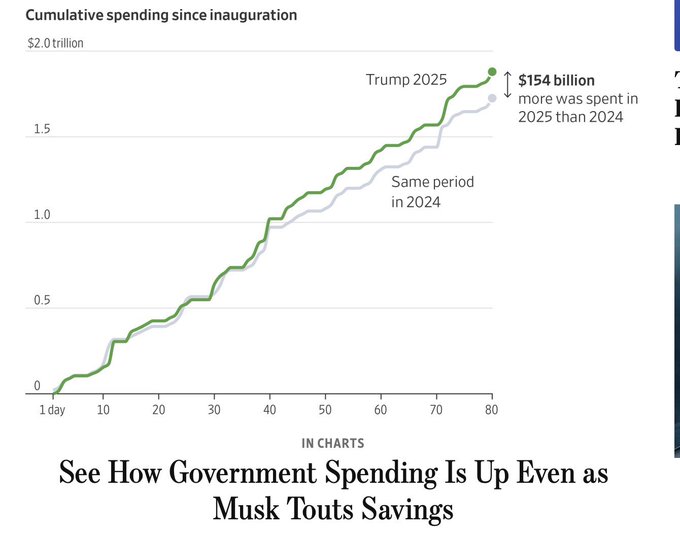
— Micah Erfan (@micah_erfan) April 11, 2025
Elon Musk has reduced the claims about what DOGE is saving from $1-2 trillion to $150 billion.
The NYT reports he’s still getting the numbers wrong through things like accounting errors and cancelling contracts that don’t exist.
What a fraud from start to finish.
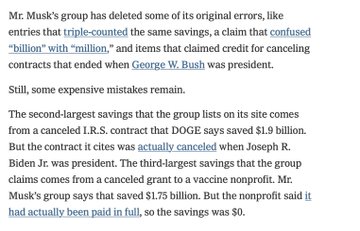
— Richard Hanania (@RichardHanania) April 13, 2025
DOGE as destruction: Tearing down the highly efficient Social Security Administration, as opposed to taking on the pork machine of defense spending. On April 14, the Social Security Administration cut its phone staffing and also changed its policy so that “sensitive” information like bank details will no longer be taken over the phone. That means that if you can’t sign up for Social Security successfully online, you will have to go to an office…where getting someone to see you is Kafkaesque….and DOGE has promised to shutter offices.
And even before that, the Social Security site was already crashing, thanks to IT cuts. So even if you were to manage to get to see a live person at an office, if the system was down, they would not be able to address your issue.
And DOGE employees are still trying to defy a court order and access Social Security data…even with not just old hands but even some Trump officials in opposition. From the Washington Post:
Representatives of Elon Musk’s U.S. DOGE Service have sought for weeks to get around a court order barring their access to sensitive data and internal systems at the Social Security Administration, prompting career staff to repeatedly resist their efforts, according to a half dozen people familiar with the DOGE team’s actions and records obtained by The Washington Post.
The battle inside the agency led the Justice Department to intervene to deny DOGE access to the data, even as the Trump administration installed and promoted DOGE-friendly leaders to dramatically cut back services at Social Security.
Please read the piece in full. The reporting is impressive and revealing.
DOGE as fraud: Taking credit for finding abuses so well known they’ve been the subject of Congressional hearings, and resulted from Trump 1.0 expanded unemployment benefits. From Associated Press:
The latest government waste touted by billionaire Elon Musk’s cost-cutting Department of Government Efficiency is hundreds of millions of dollars in fraudulent unemployment claims it purportedly uncovered.
One problem: Federal investigators already found what appears to be the same fraud, years earlier and on a far greater scale…
“They’re trying to spin this narrative of, ‘Oh, government is inefficient and government is stupid and they’re catching these things that the government didn’t catch,’” says Michele Evermore, who worked on unemployment issues at the U.S. Department of Labor during the administration of former President Joe Biden. “They’re finding fraud that was marked as fraud and saying they found out it was fraud….
Though states have almost complete control over their own unemployment systems, special relief programs — most notably widely expanded benefits enacted by the first Trump administration at the outset of the COVID pandemic — inject more direct federal involvement and a flood of new beneficiaries into the system….
Trump signed the COVID unemployment relief into law on March 27, 2020, and from the very start it became a magnet for fraud. In a memo to state officials about two weeks later, the Department of Labor warned that the expanded benefits had made unemployment programs “a target for fraud with significant numbers of imposter claims being filed with stolen or synthetic identities.”…
A Labor Department spokeswoman did not respond to questions about Musk’s findings and DOGE gave no details on how it came to find the supposed fraud or whether it duplicates what was already found.
Though DOGE ostensibly looked at longer timeframe than federal investigators previously had, it tallied just $382 million in fake unemployment claims, a tiny fraction of what investigators were already aware.
DOGE as fraud: After loudly promising transparency, DOGE is anything but. From Politico:
DOGE KEEPS IT UNDER WRAPS: The battle to pierce the veil of secrecy surrounding DOGE and its operations is coming to a head in several lawsuits…
Many of the anti-DOGE….lawyers are trying to answer questions like: What is the basic structure of DOGE? Which officials were involved in cutting-and-slashing efforts? And what sort of access does DOGE have to sensitive agency systems?…
But the Justice Department is fighting vigorously to shield DOGE from having to divulge that information, despite Trump and ELON MUSK’s repeated assurances about transparency. The administration has refused to provide testimony from virtually every official that plaintiffs have tried to depose — and especially from people who work for DOGE.
The entire Politico piece, which goes through several cases of persistent evasiveness and misdirection, is worth reading.
DOGE as a fraud: Endangering national security, stealing data apparently to target opponents like organized labor. This is a much bigger caper than the Watergate break-in, but hacking is so common that even when insiders do it to abuse their power, the outrage is muted. From NPR which broke the story:
In the first days of March, a team of advisers from President Trump’s new Department of Government Efficiency initiative arrived at the Southeast Washington, D.C., headquarters of the National Labor Relations Board.
The small, independent federal agency investigates and adjudicates complaints about unfair labor practices. It stores reams of potentially sensitive data, from confidential information about employees who want to form unions to proprietary business information.
The DOGE employees, who are effectively led by White House adviser and billionaire tech CEO Elon Musk, appeared to have their sights set on accessing the NLRB’s internal systems….
But according to an official whistleblower disclosure shared with Congress and other federal overseers that was obtained by NPR, subsequent interviews with the whistleblower and records of internal communications, technical staff members were alarmed about what DOGE engineers did when they were granted access, particularly when those staffers noticed a spike in data leaving the agency. It’s possible that the data included sensitive information on unions, ongoing legal cases and corporate secrets — data that four labor law experts tell NPR should almost never leave the NLRB and that has nothing to do with making the government more efficient or cutting spending.
Meanwhile, according to the disclosure and records of internal communications, members of the DOGE team asked that their activities not be logged on the system and then appeared to try to cover their tracks behind them, turning off monitoring tools and manually deleting records of their access — evasive behavior that several cybersecurity experts interviewed by NPR compared to what criminal or state-sponsored hackers might do.
Threats against the whistleblower have a guilty look:
crazy. an NLRB whistleblower who shared concerns about DOGE’s activities with government officials was subjected to attempted blackmail and/or surveillance, likely by DOGE staff, in retaliation. pic.twitter.com/gyJrwYB2Fw
— Nat Purser (@NatPurser) April 15, 2025
DOGE as incompetent: exposing logins. Leaving tech doors unlocked is either incredibly amateurish or done deliberately to get something in return. Russians of course are one of our default bad guys. Readers can opine as to how hard it is to create the appearance of a “Russian IP address”. A VPM could achieve that, FFS.
Some (circumstantial) evidence that DOGE sloppiness is risking national security:
A Russian IP address has near real-time access to login credentials for DOGE accounts on federal systems. https://t.co/eajfmb0CRt pic.twitter.com/ccmoFxkhbj
— Santi Ruiz (@rSanti97) April 15, 2025
DOGE as fraud: Forcing resignation of tech experts, thus risking cyber attacks. People who actually know something about the relevant entity and have some tech chops might show up DOGE, and worse, rat out to external parties how DOGE is doing a piss poor job. One fresh case is the resignation of DoD ‘SWAT team of nerds.’ From Politico:
Under pressure from the Elon Musk-led Department of Government Efficiency, nearly all the staff of the Defense Digital Service — the Pentagon’s fast-track tech development arm — are resigning over the coming month….
The Defense Digital Service was created in 2015 to help the Pentagon adopt fast tech fixes during national security crises and push Silicon Valley-style innovation inside the Pentagon. It built rapid response tools for the military during the Afghanistan withdrawal, databases to transfer Ukrainian military and humanitarian aid, drone detection technologies and more.
Without the program, some key efforts to streamline the DOD’s tech talent pipeline and counter adversarial drones will be sunset…
Several other digital modernization efforts within the government have met similar fates. The U.S. Digital Service, which helped the government modernize its technology and attract tech talent, has now been subsumed by DOGE, amid mass layoffs and firings. A program called 18F, a technology unit within the GSA, was eliminated by DOGE as well….
One former senior Pentagon official, who asked not to be named because of possible retaliation, described DOGE’s wider incursion into the Defense Department as damaging and unproductive
“They’re not really using AI, they’re not really driving efficiency. What they’re doing is smashing everything,” the former official said.
DOGE as destructive: Infighting as agency chiefs correctly point to DOGE doing damage, here killing people:
BREAKING: In a stunning moment, Donald Trump’s Transportation Secretary just blamed Elon Musk and DOGE for cuts after multiple fatal aircraft crashes. This is shocking.
— Democratic Wins Media (@DemocraticWins) April 11, 2025
Recall that the New York Times had earlier reported on a Cabinet meeting row where Elon Musk pressed Secretary of State Mario Rubio over allegedly not having gotten rid of enough State staffers, which Rubio vigorously contested. Trump somewhat backed Rubio by calling for cuts to be surgical. But regardless, this was a behind-closed-doors dispute that was made public, and not one taken straight to the press.
And then we have ideological enforcement. Covid was supposedly a big Democratic party invention to allow for a power grab, ergo Covid was fake, ergo no need for Covid testing:
DOGE just shut down San Diego County’s wastewater testing system. No more research or monitoring for deadly diseases despite the critical role wastewater surveillance played in fighting COVID. Dangerous and really stupid.https://t.co/3e2LzRnnfs
— Mike Levin (@MikeLevin) April 15, 2025
And even the 250th Fourth of July celebration is also being jeopardized, although in light of the apparent “wreck the US as we know it” exercise, this is fitting. From Axios:
The big picture: State humanities councils planning 250th anniversary celebrations all over the country have had their funding slashed, and those organizations tell Axios they likely won’t be able to execute the big, patriotic plans they had been making.
Trump has called for an “extraordinary celebration” next summer….
The chair of the National Endowment for the Humanities is part of that task force, and state humanities councils across the country had a leading role in planning public events to mark the occasion.
But 80% of the NEH’s staff was placed on administrative leave earlier this month…
Those layoffs came just days after the 56 state and jurisdictional humanities councils were alerted that their funding grants were being terminated.
“These were funds that were already appropriated, that had already been distributed through a competitive process, and they had already been under contract to be provided,” said Julie Ziegler, the CEO and executive director of Humanities Washington.
The latest: The National Endowment for the Humanities on Monday opened applications for 250 challenge grants, worth up to $25,000 each, for projects related to the “founding of the American nation, key historical figures, and milestones that reflect the exceptional achievements of the United States” in honor of the anniversary.
But state officials say the cuts have already prompted them to shed staff and suspend new programming, so even the possibility of new anniversary-specific funding would not fill the massive gap.
DOGE survivors, for now. Despite being an early and high profile DOGE target, the Consumer Financial Protection Bureau, though a bit bloodied, is still standing. From Fortune:
On Tuesday evening, Sen. [Elizabeth] Warren and fellow Democratic Sen. Andy Kim, who both sit on the Committee of Banking, Housing, and Urban Affairs, demanded investigations into a push to slash the CFPB’s workforce and cancel its contracts….
A federal judge has temporarily reversed some of the initial cuts at the agency. As part of a lawsuit between a union representing CFPB employees and Vought, a judge ordered the CFPB to reinstate all its probationary and term employees. The order also blocked the agency from terminating employees without cause, issuing a reduction-in-force, or directing employees to stop work or take administrative leave while the case moves forward—though an appeals court said last week that the CFPB could allow work stoppages that didn’t interfere with its statutory duties.
Note that legal experts have repeatedly opined that DOGE can’t cancel contracts, but if DOGE breaches them by withholding payment, they can still kill the contractors since many need the money. That in many cases will have the effect of the victims getting a recovery if they have the means to put up a fight, while the government won’t get the work they will wind up (to at least a degree) paying for. Of course, DOGE wants to destroy firms that can help with enforcement of regulation, so cost is really not an objective, despite that serving as the pretext.
https://www.nakedcapitalism.com/2025/04 ... ction.html
Don't expect to Dems to save us. The 'good cop' is still a cop.
